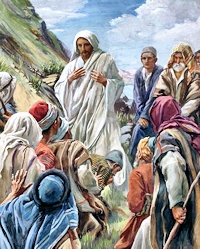Easter: April 29th
Memorial of St. Catherine of Siena, Virgin and Doctor of the Church
» Enjoy our Liturgical Seasons series of e-books!
Today is the Memorial of St. Catherine of Siena (1347-1380). She was born Catherine Benincasa in Siena at a date that remains uncertain, was favored with visions from the age of seven. Becoming a tertiary of the Dominican Order, she acquired great influence by her life of prayer and extraordinary mortifications as well as by the spread of her spiritual writings. Her continual appeals for civil peace and reform of the Church make her one of the leading figures of the fourteenth century. Worn out by her mortifications and negotiations she died in Rome on April 29, 1380.
The Roman Martyrology also commemorates St. Hugh of Cluny (1024-1109), a prince related to the sovereign house of the dukes of Burgundy. He was an adviser to nine popes.
Meditation for Monday of the Fifth Week of Easter:
The perfect gift
1. In the Epistle, St. James, the first bishop of Jerusalem, speaks to us. He addresses himself first to the Jewish Christians, then to all the rest of us.
2. "Let no man, when he is tempted, say that he is tempted by God. For God is not a tempter of evils, and He tempteth no man. But every man is tempted by his own concupiscence, being drawn away and allured" (Jas. 1:13 f.). Only that which is good can come from God. Whatever God can give and does give is always a perfect gift. Thus, "of His own will He hath begotten us [the baptized] by the word of truth, that we might be some beginning of His creatures" (Epistle). This is the good gift, the perfect gift, which God gives us: the gift of rebirth by water and the Holy Spirit. We are first and above all the predestined, the consecrated children of God. Today we thank God for this perfect gift of His love and mercy. In humility we ask why God gives this perfect gift to us in preference to millions of others who were more deserving of it than we were. Why does he not tire of continually giving this precious gift to me, who am so unworthy? He renews this gift continually in the sacraments of penance and the Eucharist, and in many other channels of grace. It is His love that prompts Him to do this.
"Let every man be swift to hear, but slow to speak, and slow anger. For the anger of man worketh not the justice of God. For the anger of man worth not the justice of God. Wherefore, casting away all uncleanness and abundance of naughtiness, with meekness receive the ingrafted word, which is able to save your souls." "Be slow to speak and slow to anger"; be not easily aroused and easily vexed; become not easily embittered or irritated. What is pleasing to God cannot be produced in anger. This good gift of God produces in each soul a love of silence and seclusion, so that the soul rests in God. It produces in the soul a meekness and a supernatural calm and peace which are far removed from all animosity and evil. It excludes and overcomes all impatience and irritation. This meekness springs from the fire of love, from self-conquest, from the peace that envelops the soul that is possessed and enlightened by Christ.
In such a soul the sensitiveness of the easily irritated, impatient man, with his degraded and unspiritual inclinations, is replaced by Christian meekness, which gives strength and mastery over one's evil tendencies, and victory over self-love and that sensitiveness so characteristic of the worldly man. Such heroic meekness is born of God; but anger, impatience, and sensitiveness are not born of God, nor of grace, nor are they the fruit of regeneration. Anger is a weakness which attempts to hide behind violent words or deeds, which are unworthy of one who is reborn through Christ. "Blessed are the meek" (Matt. 5:4).
3. With the liturgy of the fourth Sunday after Easter we recognize the "perfect gift," which comes down to us from the Father of light, to be the Holy Ghost, whose coming we await. Through His Word, God has made us His children. Through His Word, that is, through Christ, He gives us the Holy Ghost. On our part we must prepare our souls for His coming through prayer, through the practice of silence and through an ardent longing for him.
When we bring our gifts to the altar at the Offertory of the Mass, we repeat with grateful hearts the words of the Offertory prayer: "Shout with joy to God all the earth, sing ye a psalm to His name; come and hear, and I will tell you, all ye that fear God, what great things the Lord hath done for my soul, alleluia." Among the great things the Lord hath done for my soul is the regeneration of that soul. Then, too, He has bestowed on me the sonship of God, making me share the spirit of Christ; He has given me membership in His Church, and has sent to me the Holy Ghost.
—Benedict Bauer, O.S.B, from The Light of the World, Vol II






